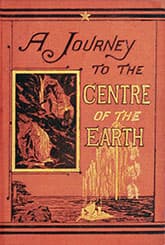A Journey to the Centre of the Earth
Critique • Quotes • At the movies
 First U.S. edition, 1874
First U.S. edition, 1874Original title
Voyage au centre de la Terre
Also known as
Journey to the Centre of the Earth, A Journey into the Interior of the Earth
First publication
1864, expanded 1867
Literature form
Novel
Genres
Science fiction, adventure
Writing language
French
Author's country
France
Length
Approx. 73,000 words in English translation
Disbelief happily suspended
The great thing about Jules Verne's stories of fantastic voyages is that they don't come across as fantastic. At least while we're reading, we believe we could fly across the world in a balloon, ride a rocket to the moon, travel under the seas...or plumb the depths of volcanoes toward the centre of the earth.
Some of these trips we know now are unlikely. They've been debunked by more recent scientific discovery. Others have proven to be more feasible, to the point that we may think of them as everyday experiences now.
But the stories were both credible and exciting for readers in Verne's day and, more to the point, still are for modern audiences. (Evidence is in the continued adaptation of the novels into films today.)
Embarking on A Journey to the Centre of the Earth, a reader may at first smirk, knowing today that the earth's core is a highly pressurized ball surrounded by intensely hot molten rock or liquid, which we are unlikely to ever get close to—let alone penetrate.
But incredulity dissipates as one reads on. Verne spends a surprising amount of time in the first part of this novel following the research of fictional geologist Otto Lidenbrock and his nephew Axel, as they search through runic scripts, decipher coded reports of previous trips into the interior, and trade information about the state of then-current scientific knowledge of the earth. It all seems so educational.
It also helps that readers can identify with Axel who is set as the skeptic, questioning his uncle's radical ideas and bringing us along as he is won over to the professor's views.
Misleading title
Slowly the skeptical reader becomes invested in the hopes and dreams of our scientific protagonists. Climb down the inside of an inactive volcano in Iceland into the bowels of the earth? Eventually the response changes from "That'll never work!" to "It'd be cool if it did!"
It also become clear that, despite the book's title, no one is actually reaching the planet's centre. At most they get some miles below Earth's surface, where they discover a subterranean ocean and surviving dinosaurs.
If this seems somewhat fanciful, bear in mind A Journey to the Centre of the Earth is scientifically far in advance of other subterranean adventure stories of the Victorian era. Edward Bulwer-Lytton's story of the Vril people in The Coming Race, for example, is a joke compared to Verne's carefully worked out opus.
If there's one part of A Journey that goes too far, it's how the party of explorers, blocked by a cave-in, manage to get back to the earth's surface. But by this time we're happy enough for them to overlook their beyond-lucky escape.
Whether we believe the story or not (I'm guessing most would say "not), it's a pleasure to share the somewhat naïve sense of wonder and hopefulness that our heroes in this novel felt about scientific exploration in a world giving up its secrets to those who dared to look for them. As it still is today.
— Eric
Critique • Quotes • At the movies

